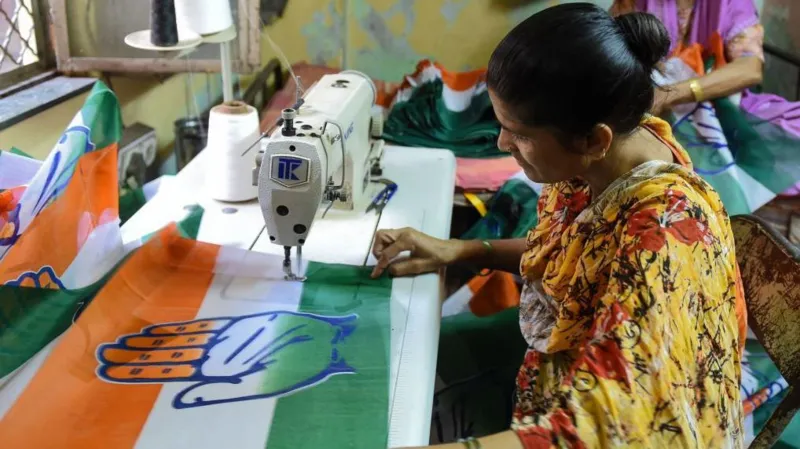50 jobs, 30 years: The unseen labour of an Indian female worker
Syeda X, a poor migrant woman living in shanty towns that skirt India’s capital Delhi, struggled through more than 50 jobs in 30 years.

She trimmed jeans threads, cooked savouries, shelled almonds and made tea strainers, door knobs, photo frames and toy guns. She also stitched school bags and did bead and jewellery work. Despite her hard work, she earned meagre wages, like 25 rupees (30 cents; 23 pence) for assembling 1,000 toy guns.
The protagonist of a new book, The Many Lives of Syeda X, by journalist Neha Dixit, Syeda relocated to Delhi with her family in the mid-1990s after religious riots in the neighbouring state of Uttar Pradesh. Reported over 10 years with more than 900 interviews, the book highlights, in part, the precarious life of an Indian home-based female worker.
Ms Dixit’s book shines a spotlight on the invisible lives of India’s neglected female home-based workers. After being recognised officially as a distinct category of workers only in 2007, India defined a home-based worker as someone who produces goods or services for an employer from their own home or chosen premises, regardless of whether the employer provides equipment or materials.
A kite maker - women comprise about 17 million of the 41 million home workers in India
Over 80% of working women in India are employed in the informal economy, with home-based work being the largest sector after agriculture. Yet, no legislation or policy supports these women.
Wiego, an organisation that supports women in informal employment, estimated that by 2017-18, women comprised about 17 million of the 41 million home-based workers in India. These women represented approximately 9% of total employment. Their numbers in the city have grown faster than in India’s countryside. “The centre of gravity in home-based workers appears to be shifting to urban areas,” says Indrani Mazumdar, a historian who has worked extensively on the subject.
Bereft of social security or any protection, these women are in a constant battle with poverty, precariousness and wayward spouses. Often their family’s main breadwinners, they strive to earn enough to educate their children out of poverty. These women also face the brunt of climate change, losing livelihoods and running losses: monsoon waterlogging in their homes leads to wastage of their supplied material.
In India, around 75% of female workers in manufacturing work are home-based, says economist Sona Mitra. “These women are recorded as self-employed and they are largely invisible,” she adds.
Ms Dixit’s harrowing narrative portrays Syeda X and other home-based working women as archetypes of helplessness and exploitation. No-one knows who sets the abysmal rates for their work. No-one provides instructions, training, or tools. These women rely solely on each other to learn how to get the job done.
Finding work is also often about following the news cycle, Ms Dixit writes.
When Kalpana Chawla became the first Indian-origin woman in space in 1997, women dressed plastic dolls in hand-stitched white spacesuits. During the 1999 cricket World Cup, they stitched hundreds of cheap footballs. A viral 2001 rumour about a “monkey man” attacking people in Delhi spurred a demand for masks resembling the creature to be sold at traffic crossings. During elections, they made flags, key rings and caps for political parties. When schools resumed, they packed crayons and school bags and bound books.
Until the 1990s, the readymade garment industry outsourced many tasks to home workers
Many women also find it difficult to get home-based work for more than 20 days a month. Ms Dixit writes that only those who don't negotiate rates or ask too many questions, buy their own tools, deliver on time, never ask for advances or help during crises and tolerate delayed payments are able to find work easily.
The precarity of female home workers has increased due to changes in the nature of the work, according to Ms Mazumdar. Up until the 1990s, the readymade garment industry outsourced many tasks to home workers. This shifted in the 1990s as factories began bringing tasks in-house and machines replaced human labour, particularly for embroidery. "Home-based work became very volatile," she says.
In 2019, the International Labour Organisation, drawing on household surveys in 118 countries, estimated there were around 260 million home-based workers worldwide, representing 7.9% of the global employment.
Research from Brazil and South Africa shows that monitoring work conditions and protecting workers' rights in subcontracted or home-based work is possible when local governments and trade unions collaborate effectively.
A woman makes paper bags at her home to sell it to shopkeepers in Prayagraj
Such examples in India are few and far between. There's the 52-year-old Self Employed Women’s Association (Sewa), a membership-based organisation that unites poor, self-employed women in the informal economy. There are self-help groups of home-based workers and micro-finance to support them. "But these schemes have really not helped them when it comes to employment," says Ms Mazumdar.
In 2009, women in Delhi who shelled and cleaned almonds from homes stopped working, demanding better pay and overtime, among other things. (They were paid 50 rupees for cleaning a 23kg bag for 12-16 hours.) The strike paralysed the almond processing industry at its peak season.
A study in Tamil Nadu state by social scientist K Kalpana illustrated how home and neighbourhood-based female workers subcontracted to make appalams (papadum) in Chennai successfully defended their rights, despite government agencies ignoring claims of trade unions.
Syeda X and her friends had no such luck. “If she ever took time off to nurse an illness or to attend to her children, her job would be lost to another faceless migrant, fighting to take her place,” writes Ms Dixit. Displacement and hardship were the only constants in her life, shifting from job to job and home to home.
-BBC N







